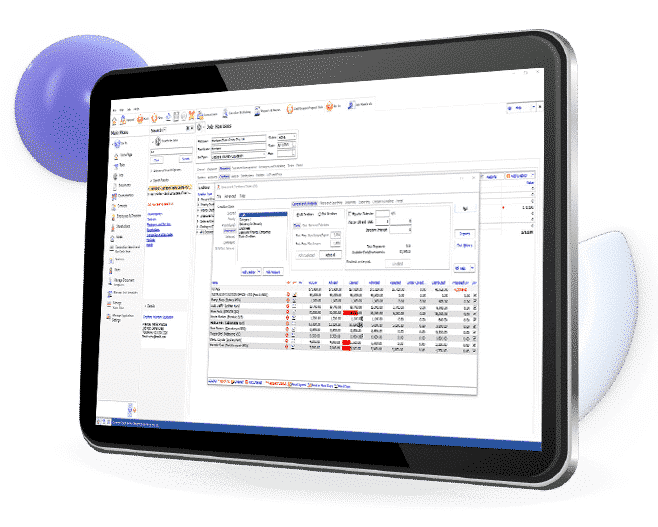The next generation of corporate insolvency case management software, offering an end-to-end solution

Aryza Insolv: a focus on assisting professional restructuring firms, to move toward a more connected, flexible, and results-driven culture
Aryza has over 20 years’ experience in the insolvency and debt management sector, and it was one of the pioneers of introducing automation to the sector. Our Corporate insolvency solution includes:
- Banking integration
- Single touch payroll (STP)
- Online voting
- Business process automation
- ARITA standards
- Payment authorisations
- Insolvency Case Management Systems (CMS)
- Auditing and security
- Compliance
- Creditors’ portal and voting online
- Integrations
- Cloud services
Banking Integration
Spend less time entering payments and more time evaluating your financial position. Make your banking systems secure and audit friendly.
-
Unprecedented level of security and audit history
-
View statement detail
-
View a centralised reconciliation of all accounts
-
Produce bank statements and part of statutory compliance workflow
-
Auto create bank fees and interest.
-
Make payments electronically and securely
-
View the bank cleared status of uploaded transactions
-
Integrate banking alerts and approvals into your workflow
-
Receive daily bank movement alerts
-
Send payment remittance advices

Creditor Portal and Online voting
Allow voting in real time, allow attendees to complete proxy forms, allow one person to represent multiple parties and vote based on number and value. Determine results and post outcomes in real-time.
The creditors’ portal provides the latest in creditor communications:
- Post documents to creditors using our online repository
- Allow creditors to securely submit their claims and bank details
- Branded for your practice
- Allow creditors to vote in real-time in meetings or on resolutions online. Display the outcome.
We provide a separate claim processing channel that is designed for class action distributions.

Click the button to log in or register for the Creditors’ Portal
Single Touch Payroll 2
STP is the new way of reporting tax and super information for employees to the ATO. When employing people as part of an insolvency appointment, we can help you.
Each time you create a payroll entry or a payment to an employee you can submit STP electronically using our ATO authorised software. Payroll has always been a part of Aryza Corporate CMS and we cater for all types of payments that need to be reported under STP.

Business Process Automation
Automation starts with small steps. Whether it is document production and approval, compliance management, payment authorisations, DMS integration, company search integration, or process automation through the web. Let us help you become more efficient.
Dive into your business processes to turn time-consuming processes from challenge to strength, so you can spend your time more productively.
Let us assist you with a managed implementation plan for special projects.

Meeting ARITA Standards
With the full suite of ARITA templates and updates, ensure your document packs are always tuned in to the latest legislation. Super charge your document production by harnessing the power of ARITA industry standard templates and precedents to ensure your processes are up-to-date and you cover all bases.
If you subscribe to ARITA templates, then contact support for our pre-coded document packs and tasks.
We provide all templates pre-coded and distributed for you.


Benefits of Aryza Corporate insolvency solutions
Benefits of Aryza Corporate insolvency solutions
Efficiency for your business and your customers
Supporting the Insolvency Practitioner
Consistency and compliance
Automation of your business processes
FAQ
To submit a STP batch double-click on the Batch:
The STP Submission Form appears.
Confirm the input information:
Select test case: Test Submit (This option is only available for administrators, and is only accepted with ABN numbers reserved by the ATO for testing ..eg the one listed above)
Lodging as intermediary: “False”
This option is much like how a tax agent will submit returns on behalf of other entities. Selecting “True” and specifying your Practice’s ABN depends on whether you want to access your submissions from a central online business portal (for your practice) or you have separate access to a portal response for the job you’re submitting the data for. You don’t need a separate registration to receive response messages as these will come back via this submission process.
Date of Payment: will be the batch date, ensure the payments to employees have the same date as the payment date.
Payroll period: Defaults from the Pay Wages entry or the date of employee dividends. Some entries will not have a payroll period so you will need to enter it.
Final pay event for the financial year: Set this to true if you know this is the last STP submission. If you have some employees having a final payment and some expecting more payments, you will need to split the batch or just submit an non-final submission by setting this option to “False”.
If you are transitioning between job types you will need to do a Final Full Submission for the current CAC (eg VA). Future submissions for the new job type (eg CVL) will be submitted under the new CAC.
Once you have progressed through the previous stages:
Inputs | Validation | Schema Validation
You may now submit the payload to the ATO.
- Click “Next” from the STP > Schema Validation tab
The wizard progresses to the “Response Summary” tab and the Authorisation pop-up form appears.
- Tick the declaration box and click “Submit Now”
The payload is now submitted to the ATO.
A response may not be received for between 5 minutes and 24 hours. To keep a track of your STP submissions see Home Page Monitoring of STP batches.
Notes: When you submit a batch you’re submitting the year-to-date figures. If you submit an earlier batch you may be updating the YTD and excluding later transactions. Check the reported generated with the submission for details of what has been submitted. If you submit an earlier batch, either resubmit your latest batch, perform a Current Year Submit or a if this is the Final submission a full year submit
Following the Input step, data will be pre-validated before submission to the ATO:
Double click on the Employee to edit any details prior to submission.
Employee Validation
The employee validation includes:
Declaration Date:
The date the employer receives the tax file number declaration needs to be entered in order to submit STP unless you have already sent in and completed the paper based tax file number declaration form.
Employee State (in Address):
The STATE needs to matched to the expected list of known value of Australian States AAT|ACT|NSW|NT|QLD|SA|TAS|VIC.
The ATO rule states that if the country is not Australia then state and post code must be blank.
Employee Country (in Address);
The application uses a list of country codes as required for validation by external systems:
– employee STP outputs
It is important the Country name be entered in full exactly as it appears in the list below to resolve a match to the code.
Tax file number
You generally would have entered a valid TFN for an employee if you’re expecting to make payments.
Note: You may enter the TFN for the employee on the import spreadsheet.
Employee Phone and Email: If entered this is supplied to the ATO.
Input Validation
ABN: The job’s ABN needs to pass the validation algorithm.
Payment date: The pay date needs to be in the current financial year.
Supplier Phone: The current user PHONE number specified in their user record.
Supplier Email: The current user needs a EMAIL number specified in their user record.
Schema Validation
This step confirms that the XML produced by the software adheres to a the correct structure and each data field is in the correct format. The schema document for comparison is located in the “\\Merge Template\Schema\ATO” directory. These files will need to exist:
If an error has occurred with a submission, you may fix the errors and resubmit the batch.
Note
Some submission errors will require you to submit a replacement batch. Search the full list of STP submission issues.
Also, if you have changed any of the coding on the employee entries that has been submitted on an STP batch, you will need to resubmit the data with a new STP batch.
Navigate to the batch and click “Resubmit“.
Note
Do not submit an earlier batch if you have already submitted a later batch. Each submission contains the year-to-date figures and will pick up earlier batches.
Resubmitting
In some cases, for example where a submission has failed due to permissions, STP events may not be resubmitted as the ATO has already recorded the receipt of a failed message. In these cases you can generate a ‘Current Year Update’ to resubmit all data for the current year.
Flag as do not submit
If the ATO will not accept a batch that has previously been submitted in error (and you need to create a new submission) then you mark the submission having an error as “Flag as do not submit” using the right-click option on the STP batch submission register.
You need to submit STP on the pay date (which would be the same day as the payroll or the next day depending upon when a funds transfer is made payable to the employees). See ATO guidelines.
Submission
The STP submission process follows the following steps:
- Entering Data Inputs
- Data Validation and Schema Validation
- Submitting the STP Batch
- Responses and Resubmission
- Batch Reports
- Batch Totals
hen entering payroll transactions, the system will pickup the following transactions for STP submission:
- Pay Wages
- Employee Dividends
- Ad hoc entries allocated to employees that have been added to a batch
If an entry is allocated to an employee the system automatically recognises the entry as requiring STP submission.
STP Batches
STP transactions are added to payroll batches and become available for STP submission. (Note: you may also process a “Current Year Submit”, “full year submit” or “Prior Year Update” which will pick up entries that are not in a batch).
Single Touch Payroll submission process
Once you have posted a STP payroll batch, you will be able to submit the STP payload directly to the ATO from your desktop software.
Contact us
"*" indicates required fields









